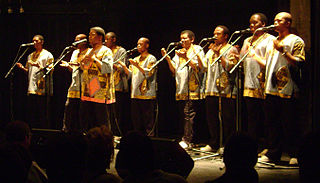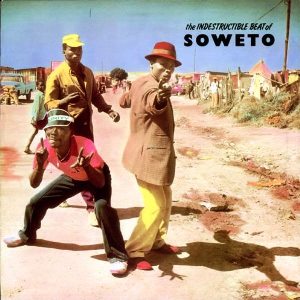
Zimbabwean music is heavily reliant on the use of instruments such as the mbira, Ngoma drums and hosho. Their music symbolizes much more than a simple rhythm, as the folk and pop style styled music was used as a symbol of hope for Zimbabweans looking to gain independence from Rhodesia. Music has played a significant role in the history of Zimbabwe, from a vital role in the traditional Bira ceremony used to call on ancestral spirits, to protest songs during the struggle for independence. The community in Zimbabwe used music to voice their resistance to their oppression, as one of the only weapons they had available to fight back with. In the eighties, the Music of Zimbabwe was at the center of the African Music scene thanks to genres such as Sungura and Jit. However, several performers were banned by state TV and radio leading to the closing of several music venues.

The South African music scene includes both popular (jive) and folk forms like Zulu isicathamiya singing and harmonic mbaqanga. Other popular (Afropop) genres are marabi, mbube, afro fusion, house music, South African pop music, rock music, South African hip hop (motswako) and South African gospel.
The music of Malawi has historically been influenced by its triple cultural heritage of British, African, and American music. Malawians, known for their history as travellers and migrant workers, have contributed to the spread of their music across the African continent, blending it with various musical forms. A significant factor in this musical amalgamation was World War II, during which soldiers transported music to distant lands and brought it back, leading to the popularity of guitar and banjo duos as dance bands by the war's end. Both instruments were imported. Additionally, Malawians working in mines in South Africa and Mozambique influenced the fusion of music styles, giving rise to genres such as Kwela.
Mbaqanga is a style of South African music with rural Zulu roots that continues to influence musicians worldwide today. The style originated in the early 1960s, and blends traditional African vocal styles and melodies with European and American popular music.

Mbube is a form of South African vocal music, made famous by the South African group Ladysmith Black Mambazo. The word mbube means "lion" in Zulu. Traditionally performed a cappella, the members of the group are male although a few groups have a female singer. In this form, groups of voices singing homophonically in rhythmic unison are employed to create intricate harmonies and textures.
Kwela is a pennywhistle-based street music from southern Africa with jazzy underpinnings and a distinctive, skiffle-like beat. It evolved from the marabi sound and brought South African music to international prominence in the 1950s.
Marabi is a style of music and dance form that evolved and emerged in South Africa between the 1890s and 1920s.

Isicathamiya is a singing style that originated from the Zulu people, a South African ethnic group. In European understanding, a cappella is also used to describe this form of singing.

The Zulu people are a South African ethnic group. Many Zulu musicians have become a major part of South African music, creating a huge influence in the music industry. A number of Zulu-folk derived styles have become well known across South Africa and abroad. Zulu music has dominated many genres in South Africa, especially house music, folk music, acapella, choral music and gospel. In fact, some of the most popular songs from South Africa are in Zulu.

Raymond Chikapa Enock Phiri was a South African jazz, fusion and mbaqanga musician born in Mpumalanga to Thabethe Phiri, a Malawian immigrant worker, and South African guitarist nicknamed "Just Now" Phiri. He was a founding member of the Cannibals in the 1970s. When the Cannibals disbanded Ray founded Stimela, with whom he conceived gold and platinum-selling albums like Fire, Passion and Ecstacy (1984), Look, Listen and Decide (1986). He collaborated with Paul Simon and Ladysmith Black Mambazo on Simon's Graceland (1986) album.

The Mahotella Queens is a South African female band formed in 1964 by music producer Rupert Bopape, consisting of Hilda Tloubatla, Nobesuthu Mbadu, and Amanda Nkosi. The group is noted for their distinct vocal harmony sound, guitar-led mbaqanga music, and fast stage dancing.

Simon "Mahlathini" Nkabinde was a South African mbaqanga singer. Known as the "Lion of Soweto", Nkabinde is the acknowledged exponent of the deep-voiced, basso profundo "groaning" style that came to symbolize mbaqanga music in the 1960s. Nkabinde was also a very active live performer in South Africa, recording and performing with the Mahotella Queens and the backing Makgona Tsohle Band from 1964 to 1971, and then again from 1983 to 1999. The Mahlathini and the Mahotella Queens act was propelled into international stardom in the wake of Paul Simon's 1986 Graceland album.

Mahlathini and the Mahotella Queens were a South African mbaqanga supergroup made up of the three musical acts linked together by talent scout and record producer Rupert Bopape at the Gallo Recording Company in Johannesburg, South Africa in 1964. The group composed of the following three distinct parts:
The Makgona Tsohle Band was a South African instrumental band that is noted for creating the mbaqanga music style. Mbaqanga is an acculturated popular South African music that emerged in the 19th century. Mbaqanga is also referred to as township jive. The group was formed in 1964 at Mavuthela, and became the Mavuthela house band. It garnered success by backing fellow Mavuthela-Gallo stars, Mahlathini and the Mahotella Queens. It is often referred to as the South African equivalent to Motown's The Funk Brothers.

Gallo Record Company is the largest record label in South Africa. It is based in Johannesburg, South Africa, and is owned by Arena Holdings. The current Gallo Record Company is a hybrid of two South African record labels, rivals between the 1940s and 1980s: the original Gallo Africa (1926–85) and G.R.C.. In 1985 Gallo Africa acquired G.R.C.; as a result, Gallo Africa became known as Gallo-GRC. Five years after the acquisition, the company was renamed Gallo Record Company.
Isak Roux is a South African born German composer born in 1959. He is known for his arrangements of South African music, especially his work with the musical groups Ladysmith Black Mambazo and Kwela Tebza.

The Indestructible Beat of Soweto, later repackaged as The Indestructible Beat of Soweto Volume One, is a compilation album released in 1985 on the Earthworks label, featuring musicians from South Africa, including Ladysmith Black Mambazo and Mahlathini. In 2020, it was ranked number 497 on Rolling Stone's 500 Greatest Albums of All Time.
Jaiva, Township jive (TJ), Soweto jive, Soweto sound or Soweto beat is a subgenre of South African township music and African dance form that influenced Western breakdance and emerged from the shebeen culture of the apartheid-era townships.
Zimbabwean Jazz, also known as Afro Jazz was developed in the 20th century. Its history can be traced from its early colonial era.













